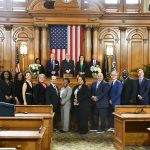VITAL
Nuna
By Jeremy Saperstein This Milwaukee trio delivers an extremely energetic and catchy disk that seems to defy pigeonholing under any convenient label. Because they’re a trio and their music offers many of the dynamic shifts that Nirvana (and the Pixies before them) did in their ascendancy, I’m sure most critics will identify them as grunge, but there’s a quality to the songs that transcends easy categorization. While leader/singer/songwriter Nuna Minch has a tendency to use the ‘f’ word as a conversational stop gap (like some people say ‘uh’ ), he has a definite way with a pop tune as evidenced in the lilting instrumentation and sing-along melodies in “Nose Candy”. While Headcase is a fine disk on its own, I’m looking forward to watching Nuna grow and expand (and to seeing them live – they play in the area fairly frequently, according to their website).
Apr 1st, 2003 by Vital ArchivesGreg Koch
By Brian Barney When Greg Koch was in the third grade, he cut out a cardboard guitar, and while using a sewing machine foot controller as a makeshift wah, proceeded to emulate Jimi Hendrix. Yeah, sure, we all did that, but Koch kept the delirium alive and went on to become one of the best and most original guitarists to ever pick up an axe. His latest release is a collection of songs, not quite songs, and spoken word that mixes music, mayhem and Kocks’ wet/dry sense of humor into a gelatinous substance called Radio Free Gristle. From its’ opening track, “The Mansqwatch Chronicles”, where a Steve Vai-like tone rides over the top of a friendly yet frightening arrangement of chord meets discord, to the last, “Your Blues” (do the math); the disc reads like a hard-boiled crime caper that you can’t put down. Standout cuts like “Chopin’s Redneck Hideaway” and “The Joy of Ax”, show Koch’s amazing approach and a style that simply can’t be categorized; where scales derail, and madness becomes melodic. Interspersed throughout the record are snippets of spoken word that range from the hilarious to the unexplainable (mostly hilarious). Koch is a Frank Zappa type for today with his musical prowess and humorous musings, and, while Radio Free Gristle will probably never reach the mainstream, fans are in for a treat with Greg Koch’s most complete work to date.
Apr 1st, 2003 by Vital ArchivesApril 2003
Dear Readers, Between the time this issue of Vital Source was created and actual press time, America entered into war with Iraq. This is one of the disadvantages of being a monthly publication, and our lack of coverage of the war and its implications, for April anyway, cannot be helped. For May, I would love to share reader letters and short essays on the war, especially from people whose lives are directly touched. Please send all correspondence to editor@vitalmilwaukee.com, or by mail to the address in the staff column. The war is being televised, and things are happening quickly. While I feel confident we’ll never fail to support our troops again (a la Vietnam), there are underpinnings to this particular conflict that, if unchecked, will bring fundamental changes to our democracy. In an increasingly technological world, access to information is the key to power. But the stripping of personal freedom and overt censorship are not the answers. Individual liberty, access to due process, and innocent until proven guilty are the cornerstones of our Constitution. Fundamentally, we as a nation agree on two key points: we want our men and women home quickly, and a swift end to the war. But we must take care that, in our zeal to “end oppression” in the Middle East, we do not eliminate oppression’s most powerful natural enemy – a nation of free peoples – our nation, the United States of America, and the democracy for which it stands. A perfect snapshot of our confusion occurred on Oscar Night. Michael Moore, in his acceptance speech for Best Documentary, was met with a mix of boos and cheers (boos were later mostly attributed to Teamster crew members) when he said (speaking on behalf of himself and others present onstage): “… we live in fictitious times. We live in a time when we have fictitious election results that elect a fictitious president… We live in a time where we have a man sending us to war for fictitious reasons, whether it’s the fictition (sic) of duct tape or the fictition (sic) of orange alerts, we are against this war, Mr. Bush.” All Oscar winners are technically given 45 seconds to speak from the stage. At precisely 45 seconds, Moore’s microphone was cut mid-sentence and the orchestra began to play. Conversely, Richard Martin’s acceptance speech for Chicago ran well over a two minutes, but contained no political references. He was not cut off. And even though Adrian Brody mentioned the war in his four minute accectpance speech, he only went so far as to wish a speedy end to the conflict and to express his support of the troops. Brody was also not censored. This may seem a small event, but all who watched the Oscars witnessed censorship first hand. We must pay attention to these breaches of free speech, whether or not we agree about their content. Consensus is not the point. Free speech is at risk. Please read Paul McLeary’s We The People. It covers […]
Apr 1st, 2003 by Jon Anne WillowFour Legs Good, Two Legs Bad
By Paul McLeary The Bush administration’s use of the English language reads like something out of a dystopian political novel. Some of its recent concoctions, like The Department of Homeland Security; Rumsfeld’s “old Europe” bon mot; the Office of Information Awareness (OIA); the USA PATRIOT Act; Weapons of Mass Destruction; the Axis of Evil and the Information Exploitation Office (IEO) are just a few of the more Orwellian terms that seem to inspire a mix of the Weimar Republic and doom itself. There are two new programs – one which has been stalled by Congress, while the other was just recently leaked to an unresponsive press – that seek to give the government broad powers to spy, gather information on and imprison American citizens on ill-defined national security grounds. The first, dubbed the Total Information Awareness (TIA) program, is being developed by the OIA, but, for the moment, has been blocked by a bipartisan coalition of skeptical Congressmen and several watchdog groups. The TIA- data mining for a safer America? The TIA program is a Defense Department research project aimed at developing and implementing broad sweeps of commercial data, called “data mining.” Targets include credit card records, Internet logs, medical data, merchant purchases and travel records. The goal is to “mine” this data in search of suspicious patterns that may indicate possible terrorist movement. If the program worked properly, it would be a boon to investigators trying to weed out possible sleeper cells in the United States. Data mining is already an established practice within companies that retain customer data. Large retailers, for example, comb customers purchase history, usually attached to indexes such as credit card numbers, customer names or other “index keys.” The information is used to identify customer habits, and ostensibly, to allow the company to make “more compelling offers” (in marketing speak) to their existing customer base. The problem, however, is that none of the drafters of the program has come forward to explain how to avoid errors in its implementation that may result in people mistakenly being tagged as terrorists, making them subject to false arrest, smear campaigns or government harassment. According to the program, the government wouldn’t have to inform anyone about the investigation, allowing officials to gather information on private citizens with no public oversight or accountability. Developed in February 2002 under the auspices of The Defense Advanced Research Projects Agency (DARPA), whose ancestor, ARPA, invented the Internet, the new office has quietly been instilled under the dubious leadership of John Poindexter, who was indicted in 1988 for defrauding the U.S. government and obstructing justice as part of the Iran-Contra scandal. Although the convictions were overturned in 1990 when Congress granted him immunity in exchange for his testimony, the joke was on Congress as the testimony he gave them turned out to be false. Since those good old days, Poindexter has been Vice President of Syntek Technologies, a major government technology contractor. We shouldn’t be surprised to learn that Syntek, with Poindexter at its […]
Apr 1st, 2003 by Vital ArchivesRivers, Railways and a Greener Milwaukee
By Matt Czarnik Milwaukee, a city built on the edge of a Great Lake and fed by the convergence of three major waterways, each supporting its own diverse and extensive natural habitat of flora and fauna, is a land capable of creating and sustaining many forms of life. Follow the ancient formula that gave birth to civilization and you’ll find that where the rivers run and spread streams into the land, people have flourished, formed cultures, developed systems and made their histories along the waterways. But gone are the days when the first settlers forged their existence by maintaining a symbiotic relationship with the earth’s precious resources, and modern humans wince at the lost motto of beauty in simplicity. In remedy, they must work with the concrete world they’ve created. For Milwaukeeans it’s not a secret how the land and waterways have been punished by the industrial age. You need only watch the water flowing through the city during the spring thaw or smell the air in summer when it mixes with the fumes escaping from the rivers and Lake Michigan. But too often, the scars left by commerce are viewed only from a distance by drivers passing over viaducts, not looking long enough to wonder what’s gone wrong and not troubling themselves to learn what’s being done for the future. But when a state’s identity (not to mention economic survival) relies on the health of its natural resources for shaping itself as a vacation destination and sanctuary for wildlife and wildlife-watchers, the idea of the state’s most populous city not guiding the conservation and preservation efforts has motivated some people to act to protect the environment on behalf of the people. Leading the recovery revolution Leading a coup d’etat for the environment is a challenge undertaken by many different, groups, from non-profit entities like the Friend’s for Milwaukee’s Rivers, the River Revitalization Foundation (RRF) and Menomonee Valley Partners, Inc., to city, county and state agencies like the Department of Natural Resources (WDNR) and local neighborhood associations. Two projects currently receiving funding on the local and federal levels, as well as private donations from partnerships and non-profit fundraising, are the proposed Beerline County Trail as an extension of Gordon Park in the historic Riverwest neighborhood and the Hank Aaron State Trail (HAST) which follows the Menomonee River from the city’s west side to Lakeshore State Park. Both will be located along the banks of rivers, the Beerline along the west bank of the Milwaukee and HAST along the Menomonee. Both are in the early stages of multi-year plans to build paved city trails that will link urbanites to recreational amenities throughout the city. Each is unique in design and location, but similar in what they offer to the revival of the water basin. The Beerline County Trail In 1987, former Governor Tommy Thompson created the Milwaukee River Revitalization Council, which, after extensive research, published the Riverway Plan. This document advises the WDNR, and stipulates that certain actions be taken to […]
Apr 1st, 2003 by Vital ArchivesRemedies for Spring’s Strains and Pains
By Jan Wolfenberg Spring is upon us, and for many, this means a sudden increase in physical activity. It’s common to greet the warm weather and bright sunshine with a generous portion of over-enthusiasm. We are all so eager to shake off the winter cobwebs and get outside! Whether gardening, golfing, or just spring-cleaning, the sudden shift away from winter’s sedentary habits can put some stress on our bodies, which we often notice in the form of aches, pains, bruises, strained muscles and sprained joints. Western medicine offers us analgesic relief in the form of over-the-counter medications like aspirin, acetaminophen and naproxen sodium (brand names omitted), as well as prescription pain relievers. But these acute conditions can usually be helped greatly by a handful of natural options that have fewer side effects and tend to work with the body instead of against it. Give yourself a break First of all, if you are sore from over-doing, it is your body’s way of telling you to give it a break. Muscles that are strained from overuse need a day or two to recover. If there is swelling that accompanies any strain or sprain, cold packs can significantly reduce soreness while alleviating swelling. Pain relievers only mask the symptoms; they don’t cure the condition, which only wants time to heal. With your symptoms masked, you are out of touch with your body’s signals, and this permits you to continue pushing yourself instead of taking the time you need to recover. Trust your body’s wisdom and listen to its signals. Second, drink plenty of fluids and eat healthy foods. Healing tissues need to remain well hydrated, and sufficient fluids also provide a way for toxins to be excreted. Stick to water, pure fruit juices and herbal teas. Soda pop only burdens the immune response and slows healing, while fruit juice cocktails aren’t much better. In fact, white sugar and corn sweeteners (found in most convenience foods) are very hard on the body in general, and especially so during healing. Choose natural foods that are minimally processed, and include lots of fruits and veggies. These foods provide your healing tissues with the building blocks they need to repair themselves. Third, don’t forget to utilize good health care practitioners who perform body work. Chiropractors can help re-align anything that needs it and are often covered by health insurance. Massage therapists can loosen tight muscles, facilitate lymphatic drainage of toxins and encourage tissue healing while providing you with a one-hour vacation from your hectic new spring schedule. Your chiropractor or massage therapist may be able to recommend specific stretches or exercises, both to aid in healing this injury and preventing one in the future. If you’ve never worked with either of these types of professionals, ask your friends for referrals. Word-of-mouth recommendations are often the best way to locate a good practitioner. Natural Remedies Nature also provides some curative herbs and minerals that we can use to help our bodies heal the effects of overuse. Two […]
Apr 1st, 2003 by Vital ArchivesThe Kids Are Alright
By John Hughes These are violent and disturbing times. With war and terrorism looming over our heads, the economy slumping and personal depression seemingly at a new high, there is more than enough to worry about. Also, the roaring din of celebrity glitter and the avalanche of plastic entertainment can leave a person feeling estranged. Yet, there is always hope, and the root of our hope is in the human spirit itself, ever renewing, perhaps even evolving over the eons. As the English poet Gerard Manley Hopkins once put it, “There lives the dearest freshness deep down things. “Perhaps that’s a little hard to see these days, but it is evident if you look hard enough. Vital Source, in a series of three interviews with five Milwaukee teenagers, found glimpses of that dearest freshness. They are Sam and Simon Barcelona, Xanthia and Alexandra Walker, and Lee LaMar; a diverse quintet, who hold as a common trait their joie de vivre, their joy of life. They are remarkable young people in our midst, and their lives refresh hope. There are good people in Milwaukee, who are ethical, fun, interested in life, making their own ways with thoughtfulness and sensitivity. They love their families, their friends, and each other. These five all share an inner peace mixed with a zest for the future, and a determination to be themselves in the face of peer pressure. It was our privilege to be in their presence. We are pleased to introduce you to them. The Barcelona brothers Sam and Simon Barcelona, ages 17 and 14, are seated in their Wauwatosa living room, looking serious for the media. They are discussing conformity to peer pressure. They are against it. “It’s more fun to be yourself than someone else,” says Sam. “I hate how you see kids at the school, and these people are from Wauwatosa, and they’re trying to be hip-hop heroes. That’s so overrated. It’s so artificial. And drugs are just huge at Tosa East. I don’t support that. It’s their choice, of course, but I’m not going to join �em. I watched other people and saw their mistakes, and I’ve learned enough about that. I don’t want it.” He is a handsome young man with dark features and long sideburns that remind me of Elvis Presley’s. When I asked if they were in tribute to the King, he laughed and reported that he doesn’t like Elvis. He prefers punk rock, which he describes as good clean energy. Simon, who attends Marquette High School as a Freshman, concurs with Simon about conformity. “It’s a bummer how everybody tries to fit in. Everybody’s holding back all the time. I don’t believe in holding back. Sam and I like to find people that don’t care what people think, and hang with them. It’s better that way.” These two young men are talkative and serious, answering my questions with thoughtfulness and deliberation. As Simon tells me that he’d like to become a pilot, possibly after attending the […]
Apr 1st, 2003 by Vital ArchivesThe Homeschool Choice
By Lucky Tomaszek “Where do your kids go to school?” “Well, actually, we homeschool,” I answer a little hesitantly. “I really like being with my kids, and homeschooling works well for our family…” I’m trying to be PC, trying not to start another controversial discussion with this well-meaning woman at Chuck E Cheese. But after letting that last sentence trail off, the silence thickens. And I realize that there is more I would like to say. I want to tell her that I have been teaching my children since the day they were born. I know them better anyone else, and know how each of them learns. I am intimately aware of their strengths and weaknesses and I know how to push them a little farther, without pushing them so far that learning becomes a chore. But it seems my opportunity has passed as we both go back to laughing at the antics of our children ascending into neon colored tubes and dropping into the ball pit. After several minutes, she says… “No offense, but why would you want to do that?” To start with, my interest was piqued when a homeschooled child won the National Spelling Bee in 1997, and again when first, second, and third place were all won by homeschooled children in 2000. And a little later in 2000 I read an article by Helen Cordes that said that homeschooled children are accepted to Stanford at “twice the rate of conventional schoolers.” I did a little more research and discovered that the average homeschooler scored in the 75th percentile on the Iowa Test of Basic Skills, compared to conventional schoolers who scored in the 50 percentile. I must admit that the tragedy at Columbine High School in April 1999, and all the other shockingly similar tales weighed in to my decision making. Of course, there was also the personal journey I made as a mother. I stay home with my kids, and I have devoted a lot of time to guiding them through childhood and helping them become loving, generous, and freethinking little people. When my oldest daughter turned five, I put her into kindergarten. I had obviously thought a lot about homeschooling, but in the end I decided that it would probably be better for her if she went through conventional school. We gave it our all! We bought the cute ‘first day of school’ dress and the box of crayons. We took a lot of pictures that day, and she was adorable. The first week went well, she seemed to enjoy school and had lots of new songs and finger plays to teach us at dinner each night. The second week was a little harder. She was more reluctant to go to school in the morning, and when I picked her up after school she had less and less to say about what she was doing all day. “What did you learn today?” I would ask. “Nothing,” she would respond. The third week was worse; […]
Apr 1st, 2003 by Lucky TomaszekThe Immigrant Student Reality
By Erin Stalnaker Proposed tuition hikes have UW students and faculty up in arms, and rightfully so. But the increase, while steep, is still only 7�o 9.4�depending on the campus and undergraduate or graduate status. So imagine the ire of students and parents alike if 2003-04 tuition rates increased 441�from $3,738 per year to $16,490. In this scenario, many students wouldn’t be able to continue their education and would end up in the non-professional, low-paying jobs traditionally filled by workers without college degrees. The immigrant student reality For most people, this seems far-fetched. But for non-resident immigrant students it’s reality. These young people must pay the out-of-state tuition rate even when they have attended Wisconsin schools from kindergarten through the 12th grade. Many graduate at the top of their class, and consider Wisconsin their only home, having lived here since the age of five or even younger. Most of these children’s parents have paid taxes throughout their residency in the state; these young people are deeply rooted here and have the potential and desire to contribute greatly to their communities. The Two Elizabeths My name is Elizabeth. I am 17 years old, and a senior in a south side high school. I came to the United States when I was 12 years old; my parents, brother and I crossed the border with visas. Since 7th grade I have always held a 3.5 G.P.A. Now that I am about to graduate and want to go to college I realize how difficult it will be, since I am not a U.S. citizen. My long-term goal is to become an immigration lawyer because I would like to fight for the justice of immigrants. Now, not only my future, but also the futures of other immigrant students who are seeking fairness and opportunity are in the hands of voters. My name is Elizabeth, and I am 16 years old. I am currently a junior in high school. Since I was small, my dream has been to be the first in my family to get a college education. Due to my legal status, it seems like a dream impossible to fulfill. I came to the United States eight years ago with my family because of poverty in Mexico. Living there, it became harder for my parents to pay for our expenses. My father decided that the best thing to do would be to cross the border illegally so he could work to send money to my mother in Mexico. When I came to this country, I knew I wanted to change my social structure and confront the stereotypes of Latinos in this country. I have a 3.0 GPA, and I enjoy volunteering. I want to become a productive adult member of my community; without an education, it is more likely that I will work in a low paying job. Two voices among many These are the voices of but two of the thousands of bright immigrant students who have the ability and the desire to […]
Apr 1st, 2003 by Vital Archives















